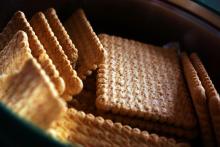Many of you will have heard that some teabags contain plastic. Consumer awareness is growing fast, following the 2017 BBC2 documentary ‘Inside the Factory’ and the situation has improved since then.
Most ‘pillow’ and ‘pyramid’ style teabags rely on polypropylene fibres embedded in the outer layer to heat-seal the edges shut. Millions of teabags are home composted or put into food waste schemes. They end up in the soil, where the microscopic plastic fibres accumulate and pose a risk to wildlife.
This environmental pollution may be invisible, but it is not insignificant. With 165 million cups of tea drunk in Britain each day, that’s a whole lot of microplastic on its way into our soil and water.
Key points
- Many tea bags contain plastic.
- The alternative, Polylactic Acid (PLA), can contain material from genetically modified sources.
- PLA teabags should go into council food waste, as they won’t break down in most home composting conditions.
- The best way to dispose of plastic tea bags is to rip them open and compost the leaves, but put the bag into the bin.
- Watch out for hidden plastics in sachets or string-and-tag bags.
What is microplastic?
Microplastics are tiny pieces of plastic, officially defined as any piece of plastic less than 5mm in size. There are two categories:
- primary microplastics are up to 5mm in size when manufactured;
- secondary microplastics are small pieces made from larger items degrading in the environment.
Research has found them turning up in all sorts of places, including seafood, salt, tap water and even in our bodies.
What are plastic-free teabags made from?
Many ‘plastic-free’ pyramid teabags are made using polylactic acid (PLA). This is a plant-based polymer (sometimes referred to as a bioplastic) which is biodegradable but not domestically compostable. It can also be called Soilon. Plant material sources include corn starch, which can come from genetically modified (GM) maize, which cannot be used in organic teabags.
Following consumer pressure in 2018 when 200,000 people signed 38 Degrees petition, PG Tips announced it was going ‘plastic-free’ for its pyramid bags, with the rest of its teabags following that.
PG Tips confirmed “Our biodegradable teabags are made from PLA which is a material derived from corn, grown in the US. Current US corn growing practices produce a mixed stream of GM and conventional (non-GM) corn. However, the processing and manufacturing process uses a high heat process, and no detectable GM material remains ... Longer term, we are working with our supplier on the development of biodegradable teabags from other sources that are non-GMO crops.”




